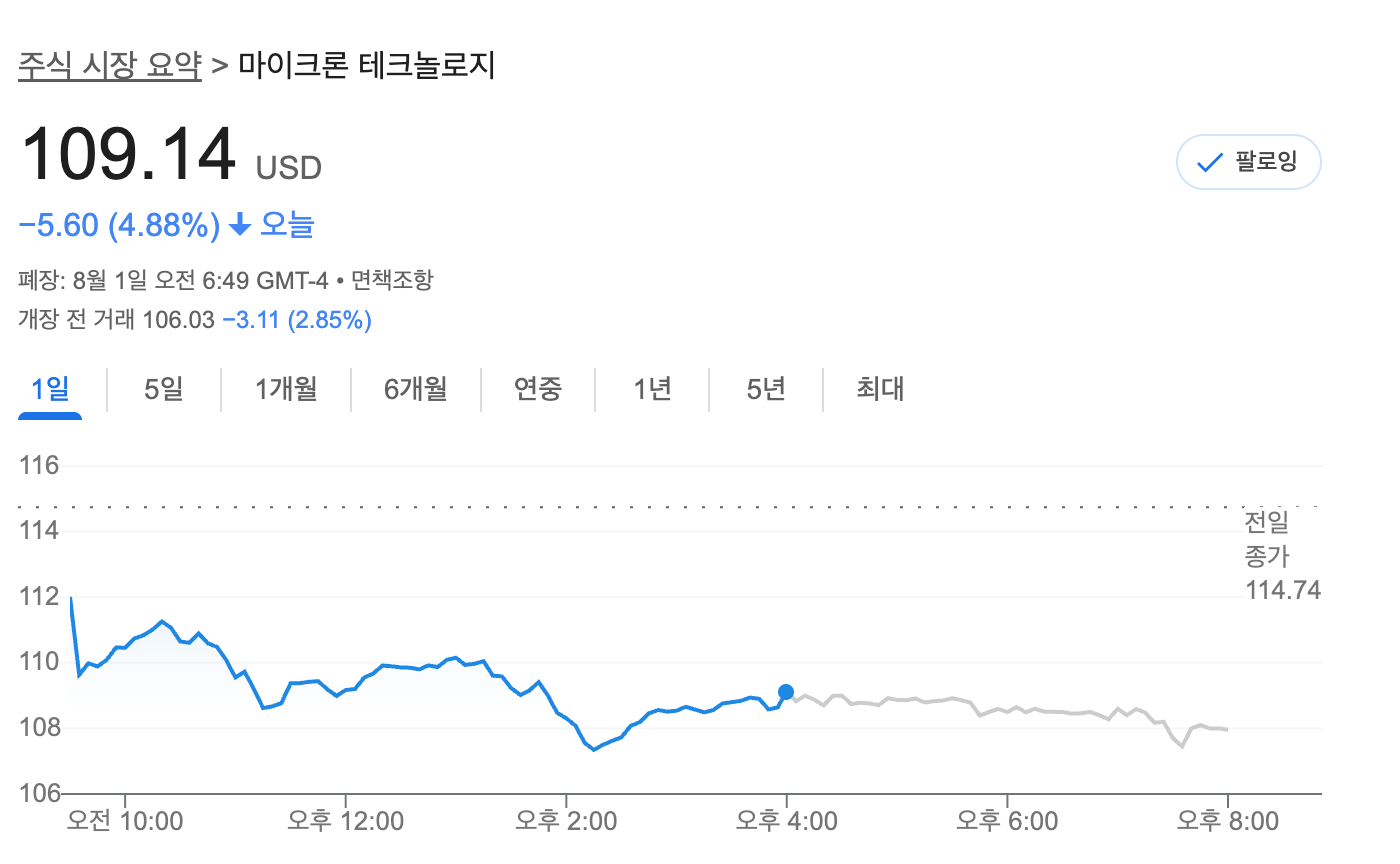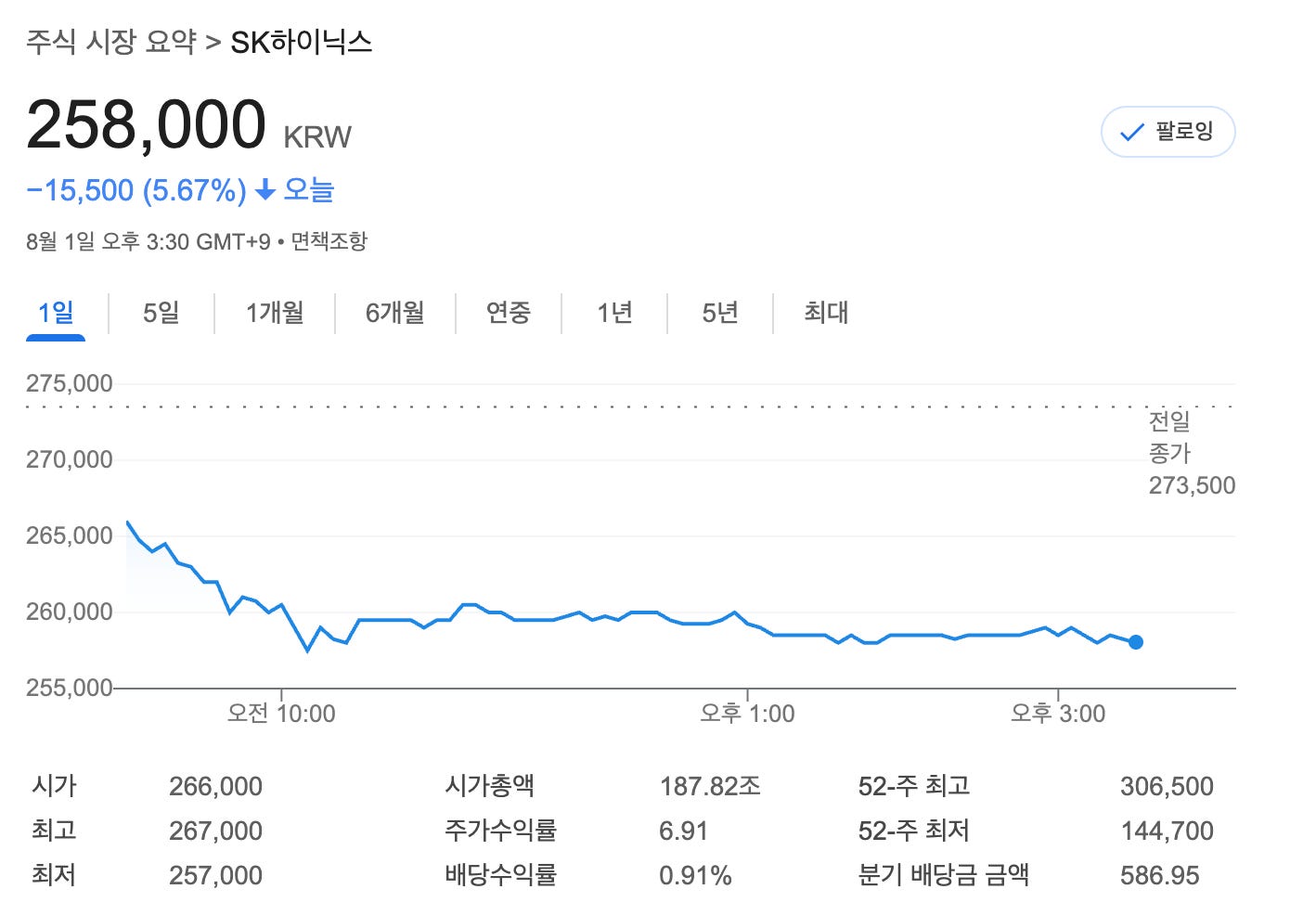TLDR:
A supply shock originating from Samsung is becoming visible.
Micron could become the biggest victim of Samsung's HBM3E chicken game.
The market conditions are expected to recover only in the second half of next year when HBM4 begins in earnest.
Before I begin, I want to disclose that I am bullish on Samsung.
Yesterday, Micron's stock price fell by about 5%.
Similarly, SK hynix's stock also dropped by about 5% today.
What is the reason? Wasn't the demand for HBM solid? Why did memory stocks suddenly undergo a correction?
I want to find the answer to this question in Samsung's conference call from yesterday.
"Regarding the intensifying competition in the HBM market, for HBM3E products, a shift in supply and demand is anticipated due to a supply increase that is expected to outpace the speed of demand growth, which will affect market prices for the time being. Considering the rising price trend of conventional DRAM in the second half of the year, the profitability gap between HBM3E and conventional DRAM will narrow sharply. Therefore, from a profitability optimization perspective, the need for a balanced product mix operation strategy may increase in the short term. However, our company, considering the mid-to-long-term demand growth of AI-related HBM and the importance of this market, will continue to focus on securing HBM3E demand while simultaneously strengthening collaboration with clients for the commercialization of competitive HBM4. As an extension of this, we will develop future products, including custom HBM, and continue with related investments in parallel."
Samsung forecasts that the price of HBM3E will fall. And it's due to an increase in supply.
Who is increasing the supply by this much?
This year's HBM market demand is 20.0-22.0B Gb. The combined supply from SK hynix and Micron is 16.0B Gb. Considering that SK hynix and Micron cannot currently increase their HBM supply beyond 16.0B Gb, Samsung must fill the gap.
According to supply chain sources, Samsung aims to supply approximately 1.5B Gb in the third quarter, a 100% increase from the previous quarter. At this rate, it is estimated that Samsung will be able to supply 4.0B Gb this year.
You might wonder if 4.0B Gb will have that much of an impact on the market. Let me tell you, The Street is severely underestimating Samsung's HBM. To put it simply, they had set their expectations far too low, as if Samsung's HBM was unusable.
This might have been the case with Samsung's HBM3E before the redesign, but Samsung has already written off the pre-redesign HBM3E as a loss and has begun to release the redesigned 1-alpha (1a) HBM3E to the market. Supply chain officials have testified that the performance of Samsung's 1a HBM3E is not significantly behind competing products.
As an example, it is estimated that Samsung has signed a contract to supply 12-stack HBM3E to Broadcom (estimated at a scale of 1.0B Gb). It is also presumed that Samsung has secured an HBM3E contract with AWS. Previously, it was expected that SK hynix would supply Tr2.5 and Tr3. And it is believed this news broke around yesterday, which led to the significant weakness in Micron's stock yesterday and SK hynix's today.
I believe it has become highly probable that Samsung will supply 12-stack HBM3E to Nvidia. Sources familiar with the matter have said that Nvidia is placing more weight on lowering the price of HBM by receiving Samsung's HBM3E than on receiving HBM with superior power efficiency.
I expect Samsung's HBM3E to pass Nvidia's qualification test around August 15th.
Furthermore, I predict that Samsung's entry into Nvidia's HBM3E supply chain will cause the most damage to Micron. It is estimated that Micron supplies over 80% of the HBM it produces to Nvidia. Unlike SK hynix, which supplies HBM3E to other ASIC companies, if Nvidia adopts Samsung's HBM3E to lower prices, Micron will inevitably take the biggest hit.
It is also noteworthy that Samsung's HBM3E back-end packaging yield has recently improved significantly. This can be interpreted as Samsung having further lowered the cost of its HBM3E, which means Samsung can sell HBM3E at a more aggressive price.
I anticipate that the price decline of HBM3E will intensify starting in the fourth quarter. This is because HBM supply will further increase as SK hynix's M15X fab comes online. This HBM3E price decline issue is likely to have the biggest impact on memory companies in the first quarter of 2026. This is because in Q1 2026, the price drop for HBM3E will be more severe than in Q4 2025, and production volume will increase further as yields improve due to the advancements in the HBM manufacturers' production learning curves. Therefore, I estimate that this short downturn will bottom out in Q1 2026.
If you ask why I think the downturn will end in the first quarter, it's because the HBM4 ramp-up will begin in the second quarter.
Let me continue with HBM4. Rubin was taped out this week and is expected to ship in the second quarter, with server products being supplied from July. Samsung delivered HBM4 12-stack samples to major clients like Nvidia in July and is estimated to provide HBM4 16-stack samples around mid-August. Unlike SK hynix, which provided dummy samples to Nvidia in March, it has been confirmed that what Samsung is supplying this time are fully functional, real samples.
Samsung's HBM4 is estimated to be about 30% more expensive than SK hynix's. This is because Samsung uses 1c DRAM for its HBM4, which involves more EUV layer processes. However, Samsung's high cost is expected to decrease over time, thanks to various factors such as increased yields from the production learning I mentioned earlier.
SK hynix is currently understood to want to supply its HBM4 12-stack products at $600 per unit, which is a 30-40% premium over the HBM3E 12-stack. However, it is understood that Nvidia is delaying the contract, stating they cannot accept that price, and is using Samsung's HBM4 12-stack as leverage to pressure SK hynix.
I estimate that Samsung will not be able to pursue an aggressive price reduction policy for HBM4 due to its significantly higher cost compared to SK hynix. Nevertheless, it is quite concerning that SK hynix's profit margin on HBM4 may decrease compared to HBM3E. In SK hynix's case, it is estimated that its profit margin could fall by about 10-15% due to the outsourcing of the base die. However, Samsung is seen as having an advantage over SK hynix because it can produce the base die in its own foundry.
The ramp-up of HBM4 from Q2 2026 is expected to end the short down cycle and bring about a memory upturn. As explained above, HBM4 has a very high cost, making it difficult for any company to attempt aggressive price cuts. Although the profit margin from HBM4 may be lower than that of HBM3E due to the increased cost, this high cost structure will act as a structural shield to suppress price dumping competition among manufacturers. This will serve as a safety mechanism to prevent a sharp decline in the memory market. Ultimately, the HBM4 ramp-up, starting in Q2 2026, will be the key variable driving a new upturn after a short correction.


![범용 HBM, '맞춤형'으로 진화…“주상복합 반도체 꿈꾼다” [아시나요] | 세계일보 범용 HBM, '맞춤형'으로 진화…“주상복합 반도체 꿈꾼다” [아시나요] | 세계일보](https://substackcdn.com/image/fetch/$s_!uLFE!,w_1456,c_limit,f_auto,q_auto:good,fl_progressive:steep/https%3A%2F%2Fsubstack-post-media.s3.amazonaws.com%2Fpublic%2Fimages%2F9de950d7-e526-48ea-b585-6cdf55338bb7_680x408.jpeg)

